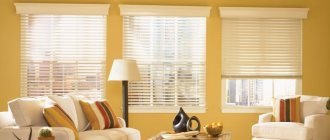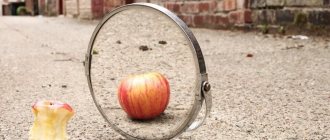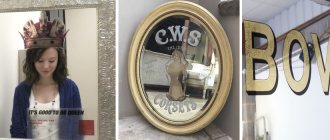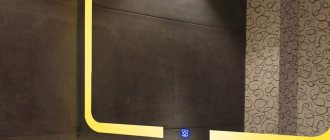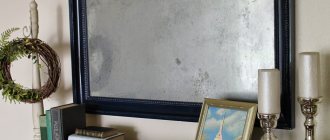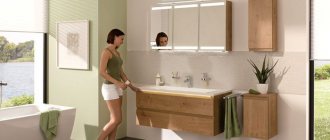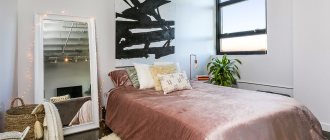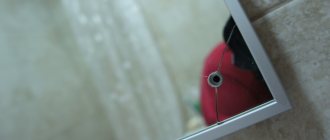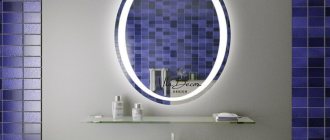In fact, you don’t need much at all to make a glass mirror. There are more professional and expensive methods that involve the use of different types of sprayers (for example, silver and chrome) and additional equipment. In the context of private use, they do not look rational, since the costs in all senses do not give the corresponding result.
Simply put, is it worth spending so much to make a mirror for your home interior? It is perhaps better to choose simple and practical methods that are accessible to everyone and do not require significant financial investments.
Types of mirrors
All mirror canvases are usually divided into two categories:
- with a functional purpose;
- decorative plan, which are usually used exclusively to improve the design.
| Functional | They are used so that a person can look in them while controlling his appearance. They are installed in visible and easily accessible places: bathrooms, hallways. There are cases when living rooms are equipped with mirrors to make them look larger visually. |
| Decorative | They don't look like people. They are intended to become a decoration of the room. |
There are many types of mirrors, and there is no shortage of choice. It all depends on individual preferences, the size of the premises, and financial capabilities. Today, retail outlets can offer the following unusual types of mirrors:
- mirrors patinated look (made in antique style). In this case, special chemicals are used;
- mirrors beveled (having beveled edges, most often in the form of diamonds);
- mirrors tinted or colored (look great in modern interiors);
- mirrors with ornaments, patterns, drawings and all kinds of inscriptions.
Types of products
Currently, there is no shortage of mirrors, and the cost of these products is quite affordable. People use all sorts of variations of reflective surfaces, among which there are cosmetic mirrors:
- Road. During the production of such models, shock protection is provided, and the products themselves are compact in size specifically for ease of transportation.
- Pocket. These are models that resemble a lady's powder compact. They come in miniature sizes and usually need to be folded and closed before being put into a pocket or bag.
- Shaving mirrors. The products are equipped with a special stand and are sometimes equipped with lighting for the convenience of the owner.
- Bags. Manufacturers of accessories insert them into frames for convenience; with their help, the owner will be able to control her appearance in any conditions.
Road
Pocket
For shaving
Bag
Interior mirrors are presented in an equally extensive range:
- wall ones have a wide variety of shapes - from classic geometric shapes to bizarre configurations;
- tabletop ones are equipped with a stand to place the product on a table or windowsill;
- mirror panels are hung on the walls, they are available in different models and are more of a decoration than a functional item;
- tiles with a reflective surface are used in room design to expand the space.
Wall mounted
Desktop
Panel
Reflective tiles
The edge of the mirror sheet is designed in different ways:
- Bevelling is a technology that involves removing sharp edges from the fabric. Edge grinding using this method is used in the production of furniture, equipment for retail and exhibition halls, and in the design of stands where mirrors with an open edge are provided.
- Euroedge – professional edge processing and polishing of the mirror end. This technology is used in furniture production, for countertops, partitions, mirror steps, glass doors and more.
- Polishing removes rough areas on the edges of the mirror. It is carried out along the perimeter of the canvas until the edge of the product becomes transparent. Polishing is used after cutting and polishing the mirror.
- The raw edge of the mirror remains after cutting. This canvas often serves as a decorative element in interior design.
The ends of the product are processed so that the mirror can be used safely, without the risk of injury from sharp edges.
Facet
Euroedge
Polishing
Raw edge
DIY materials for mirrors
To start making a mirror with your own hands, you need to decide what it will be made of. The following materials can be used:
- plastic;
- glass;
- cardboard;
- foil;
- metal.
Currently, plastic is in great demand as a reflective surface. But the technology for manufacturing such items is quite complex, and special vacuum equipment is used, the storage of which at home is impractical, unless the family has a mirror manufacturing business.
As for glass and metal, they can be used at home; highly professional equipment is not required. When silvering a mirror, you will need certain chemical reagents, but they can be easily purchased. The metal is replaced by its analogues - foil. It will be almost impossible to achieve a special quality mirror, and it will be inferior to metal and glass specimens.
Foil - a budget replacement for a mirror surface
Metal mirrors
It must be remembered that not all metals can be used in the manufacture of mirrors. It is worth using only those that tolerate grinding well. These include:
- steel;
- bronze;
- aluminum;
- silver;
- gold;
- special alloys;
- beryllium.
To find large silver or gold plates, you need to try hard, and their cost will be exorbitant. Moreover, expensive alloys are classified as soft and will not be able to rigidly hold the shape of the mirror. Therefore, they are mainly used only for spraying a surface reflective layer.
Bronze has been used since ancient times. Due to its hardness, it withstands polishing. And this is enough to make a mirror surface.
Steel is considered a younger material compared to bronze. It is widely used to produce reflective surfaces. The principle of working with steel is the same as in the previous version: a cast whole mirror surface is purchased and simply polished. To ensure that the surface has a sufficient reflective effect, it can be silvered, but you don’t have to do this.
Do-it-yourself polishing of stainless steel to a mirror finish
You can watch the video for more details about the process of polishing the material to a mirror-like appearance (in English, but it’s not important here):
Aluminum mirrors are also common. Products made from it are light and cheap, but they have a lot of negative aspects:
- aluminum is quite difficult to polish due to its soft structure, so this procedure takes a lot of time and nerves;
- softness does not allow the mirror to maintain its correct shape.
Beryllium and other special alloys are used in the production of mirrors at industrial enterprises with specialized equipment. Beryllium is very hard and toxic, so it is usually only used to coat objects.
How safe mirrors are created
Safety mirrors are made from different materials. There are surfaces made of acrylic, special unbreakable glass, in addition, there are mirror plates based on plastic made of several layers.
Safety mirrors on an acrylic basis are used for home use, in kindergartens, entertainment centers and playrooms. Such accessories are made to order. They do not break, weigh little, do not contain harmful substances and clearly convey the image. Such products can be produced in any form. Mirror acrylic lends itself well to processing. It is not afraid of moisture, so it can be used in bathrooms and swimming pools. This is one of the best and safest options for children to use.
For a child's room, you need to choose mirrors that do not have sharp edges. The surface must be securely fixed. It is better if the mirror sheet is made of plastic. If you couldn’t find one, you can use a special interior film that covers the mirror surface, and if it is damaged, it will hold the fragments, preventing them from falling apart.
Choosing glass for a mirror
If the choice is made of glass, then it should be selected carefully. Bohemian quality is best - it has a well-polished surface and is practically not subject to mechanical damage. It costs expensive.
But you can also take a regular window option, only there are certain requirements for it: its surface should not be covered with shells, cracks and visible scratches. The glass sheet must have perfect evenness and this is checked in the following way:
- The glass is placed on a flat surface covered with a dark cloth;
- A lamp is installed nearby;
- The metal measuring ruler is carefully applied to the surface so as not to cause damage;
- The lamp is directed onto the glass so that the divisions of the measuring instrument are visible on the glass surface;
- If the glass is smooth, then along the entire length of the ruler there will be no gaps between it and the surface, and its divisions will clearly correspond to the reflection without breaks.
Once the choice of glass is made, it must be cut along the contour. It is worth using a sketch that is cut out of cardboard. Such actions require a little experience, and if you do not have it, then let a specialist do the pruning. When performing such actions, precision is necessary to avoid chips and nicks.
But if you decide to carry out all the work yourself, use a glass cutter with a cutting disc. It's better than diamond.
Glass cutting
Point two: hidden cameras in the rooms
Administrators of most hotels that have video surveillance systems claim that there are no cameras in the rooms. But is it?
Imagine that you are a security officer and you need to identify a potential threat in time. Will cameras in the corridors, elevators and lobby help you? Of course no. If you do not have “X-ray vision” and other superhero talents, then you will never understand what is in the guests’ suitcases.
India: a girl cleaned a lake for two years and this story was included in a textbook
Astrologers named 3 zodiac signs that will break off relationships by the end of quarantine
Friends found a box with a key in the forest and decided to open it. There was a message
Accordingly, video cameras in the rooms are required to ensure security. And, of course, they are there. Miniature hidden cameras are installed in residential hotel premises. As a rule, they are placed in those places where you can get maximum visibility and a clear picture and where, of course, curious guests will not look.
It is impossible to detect such cameras during a visual inspection of the premises. However, even a thorough search will yield nothing. For example, you wouldn’t dismantle the ceiling panels in a hotel room or break a nice decorative figurine?
However, it is still possible to understand whether there are hidden video cameras in the room. And a regular smartphone will help you find out. You need to close the windows tightly, turn off the lights and turn on your smartphone. The screen emits a faint blue glow, in which light points projected by the “sight” of the video cameras are noticeable.
Unfortunately, even if you calculate the trajectory of the camera sight and understand where it is located, you cover this area - it is not a fact that you will get rid of surveillance. In such a situation, you just need to move to another hotel.
How to make a glass mirror with your own hands
In order for the mirror to turn out to be of high quality and to serve for a long time, it is necessary to strictly follow the following manufacturing technology:
- Select a table with the correct horizontal surface and place glass on it. To avoid breaking it during the wiping process, you need to place something soft under it.
- Pour polishing liquid over the glass surface. A ready-made “Polish” will do. Then the glass is thoroughly wiped with soft felt, felt or leather.
- Wipe the glass with gauze, previously soaked in distilled water containing a suspension of crushed pumice powder. Afterwards the surface is washed with distilled water.
- Take a wet sponge and wipe the surface with it. Then do the same using gauze swabs that are moistened with a 15% tin chloride solution, repeat the procedure several times. Rinse and wipe thoroughly using a swab.
- After completing these actions, the glass will first become dark, and then quickly lighten due to the fact that silver begins to precipitate. If dark spots appear on the glass surface, they must be removed immediately by wiping with a swab soaked in a pumice suspension, and then using gauze soaked in a solution of stannous chloride. At the end, fill the area again with freshly prepared solution.
- After 7-10 minutes have passed from the start of using gauze or suede for silvering, heavily moistened in distilled water, carefully remove the liquid from the glass in order to pour the mixture there again.
- After 15 minutes, the surface is washed with distilled water. In this case, one edge of the glass rises and the surface is filled with liquid. To determine whether the thickness of the silver deposit is sufficient, you need to look through a mirror at an electric lamp (60W). Its contours should be slightly visible.
- For a mirror to be durable, it must be subjected to high temperatures. In this case, the mirror is given a vertical position and kept in this form at 100 - 150 degrees.
- The “baked” silver film is coated with a mirror-like waterproof varnish. This is done using a spray bottle. As soon as the varnish dries, a thick layer of paint or asphalt varnish is applied to the surface. Coating on mirrors should be done in one direction.
- The final touch is to remove silver stains from the front side using a weak solution of hydrochloric acid using a swab. The making of the mirror is completed.
- If, during the manufacture of the product, droplets of silver get on the skin and clothing, then the stained areas are wiped with sodium hyposulfite and then thoroughly washed off with warm water.
You can also watch an interesting video on how to make a glass mirror using paint and enamels:
Point three: danger in the toilet
Taking care of one’s own hygiene is the personal responsibility of the guest, as is believed in almost all hotels. Of course, the room’s bathroom, shower, washbasin and toilet will be sparkling clean, but will they be disinfected? Of course not.
The number of harmful microorganisms hazardous to health in the toilet and bathroom of a hotel room can terrify any doctor, microbiologist or other specialist working with various pathogens. Moreover, the notorious E. coli is far from the only “enemy” that lies in wait for hotel guests.
A new photo of William and Charles proves that father and son have put aside old grievances
The finale of the series “Killing Eve” addressed the issue of the lack of “colored” writers
MTS will launch sales of its own “smart systems” for cars
If, when entering the bathroom or toilet, you do not notice a specific odor that remains after using disinfectants, take care of your health. The easiest way to destroy dangerous microorganisms is steaming with boiling water. As a rule, all hotel rooms have a kettle, so why not use it?
How to make a metal mirror with your own hands
Bronze and steel sheets can be purchased from a foundry. The Internet can also be used, but you should pay attention to the evenness of the surface in the information. The polishing process takes quite a long time and requires significant labor costs, but the surface layer will be perfect.
The surface is polished using abrasive powder. For a larger binder, solid oil is used. Grinding occurs using a flat iron plate with a smooth surface or a thick sheet of glass. The steps should be like this:
- The sanding pad is placed horizontally.
- An abrasive mixed with grease is applied to the workpiece.
- The workpiece moves along the grinder in various directions, but it should not be brought to the edges.
- The workpiece and grinding pad are freed from the abrasive composition using a flannel rag.
- A soft-grain abrasive is applied on top and the procedure is repeated.
The abrasive is applied up to 6 times, with each subsequent application using a softer fraction. Once the surface is ready, it is polished with GOI paste without using a grinder.
Manufacturing
The production of the very first translucent spy glasses is attributed to the American psychologist A. Gisel. Subsequently, they received his name. He was the first to observe a group of children using this specific glass and identify the features of their development.
This mirror owes its peculiarity to titanium coating or a special tinted film . Glass is coated based on metals, their oxides and nitrides. The color of the resulting product depends on this.
Titanium is a durable metal that does not lose its properties over time if used correctly and will continue to serve you. A titanium coating is applied to one side of the glass, due to which the light falling on the glass is only partially reflected. The density of the coating directly affects the degree of reflection.
As a result, we get a mirror with one slightly darkened side, but going around the object on the other side, the observer will see only transparent glass.
How to make a mirror from foil with your own hands
The most affordable way to become the owner of a hand-made mirror. Retail outlets can offer a huge selection of this material, but it’s worth focusing on the thinnest foil that exists in nature. The most suitable option would be window foil, which protects rooms from sunlight in the summer.
Manufacturing does not require special skills or effort. The glass must be smooth. Take a sheet of foil and cut it to the shape of glass. Then it is glued on the sides. The mirror is inserted into the frame and the product is ready. No complications or negative impact on human health. You can also attach the foil to the glass with tape.
One way mirror production
How does such a one-way mirror differ from a regular one and how to make it?
Regular mirrors
- This is usually glass with a reflective coating applied to its back side (various alloys of tin, silver, copper, titanium or aluminum). At the same time, the spraying is very dense and the spray layer is thick.
Mirrors with one-way transparency
are made similarly, but the coating layer is thin and allows some light to pass through.
An alternative option is to apply a translucent mirror film
. It can be applied to existing glazing.
The cost of both methods is the same, and the principle of operation is the same (see above). Resistance to mechanical stress (scratches, shocks), temperature conditions and humidity is approximately the same.
Main difference
— mirror coating is done in the workshop, automatically. Therefore, the quality of the product does not depend on the craftsman performing the work. But such glass is produced only in specialized workshops and for some time (depending on the production technology).
Mirror film
can be applied locally, incl. on existing glazing. However, applying the film requires good skills and special tools to avoid defects during gluing (bubbles, peeling, various irregularities, foreign inclusions or dust, etc.). Also, the mirror film can be applied together with a reinforcing protective film.
Cardboard mirror
The cardboard must have sufficient density and thickness. It can also be attached to a more rigid material, such as plywood. It is worth purchasing mirror auto enamel in a can and coating the workpiece with it. The finished product will not last long, and its strength will be minimal, and the reflective surface will be of poor quality. But there is a main advantage of such a mirror: it can be given any shape and decorated in any style.
Mirror cardboard
How to make a frame for a mirror with your own hands
You can make not only mirrors, but also frames for them yourself, using all your imagination. The choice of materials for manufacturing is so wide that you should be guided only by your own preferences, the style of the room and financial abilities.
An example of making a frame for a mirror
Don't think that the frame is a very expensive part. You can even use cardboard and paper tubes for a beautiful frame. Moreover, such a miracle can be done with the participation of all family members, even the smallest. Let's look at some interesting options.
- Frames made of polyurethane. They are durable and lightweight, and are not afraid of excessive humidity. You can always change its color by simply repainting it. Polyurethane molding is used for round and oval mirrors. This frame is easy to make.
- Metal frames. You can use aluminum as a thin and manageable material. If forging will look beautiful, it requires a professional approach, although the look will be unique.
- Mirror glass for frames has gained well-deserved popularity. You don't need any great skills to make it. You can purchase special coated glass or use many small glasses.
- The leather frame is quite original. It can have a voluminous appearance if filled with padding polyester. Instead of leather, you can use good quality leatherette. It is more profitable and not everyone can distinguish it from natural canvas.
- Rope frame. A rather non-standard proposal, but it will make the room more comfortable. Disadvantages include fear of moisture, temperature changes, and impracticality.
- Wooden frames. If you have already worked with this material, then building a frame will not give you much trouble. You can make a carved product, choose a specific design.
How to make a mirror with your own hands - instructions with photos and videos
5 (100%) 1 vote
Famous Pottery Barn mirror.
In this project you will learn how to make an analogue of the famous Pottery Barn mirror. Detailed description here.
Detailed description here.

